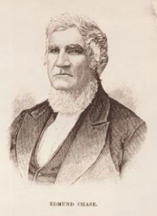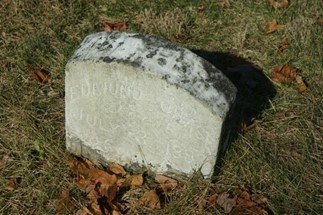

Edmund Chase, son of Clark Chase and Phebe Mason, was born on March 20 (26), 1803 in Western, Oneida County, New York. He was a brother of Willard Chase and a near neighbor of the Joseph Smith Sr. family.
In 1812, when Edmund was age nine, he moved with his family from Rutland, Jefferson County, New York to Ontario County, New York. He worked as a farmhand, earning ten dollars a month until he was able to purchase twenty-nine acres in Palmyra.[1]
Edmund married Phebe Mason on January 27, 1828 in Manchester, New York. In 1830, he paid a property tax of seventy-four cents for his twenty-nine acres valued at $290. On July 19, 1834, Edmund was listed as a soldier in the 39th Infantry of the Ontario County Militia.[2] The following year, he was granted a deed from Nicholas Evertson.[3]
Sometime in the 1840s (years not specified), Edmund exchanged his farm in Palmyra for 120 acres in Pavilion, Kalamazoo County, Michigan and 200 acres in Branch County, Michigan. He left Palmyra, New York on June 1, 1842 for Kalamazoo County, Michigan. He journeyed through Ohio and arrived in Pavilion, Kalamazoo County on July 1, 1842. Once there, he visited his friend, Mr. Cook, and found a gathering of Mormons in Cook’s house. Edmund never affiliated with Mormonism.
Edmund was a staunch Republican.[4] In 1846, he represented Pavilion on the board of supervisors. Between 1847 and 1852, he was elected supervisor of Pavilion (which was equivalent to being elected mayor).[5] In 1850, he was a justice of the peace in Pavilion. In the 1860 US Federal Census, he was listed as being age fifty-seven years old and having a real wealth of $800 and a personal wealth of $1,275. By 1870, Edmund was a retired farmer with a real wealth of $7,000 and a personal wealth of $3,000.
From an interview with Lorenzo Saunders on November 12, 1884, the following was said of Edmund—
Willard Chase claimed his sister Sally had a peep stone. The Lord bless you I have seen her peep stone a hundred times; It was a little bit of [a] stone & it was green & she would hold it before light. I was thirty years ago:—after I left there I can not tell you whether the peep stone was used or not . . . as I told Jo. Smith when he dug one out of a well on Chase’s Farm in the Shape of a baby’s foot. They dug that hole for money. Chases and Smiths altogether was digging. I knew all about the stone; Edmund Chase told me all about it. He lives here now, this side of Kalamazoo. He is a man older than I am. His name is Edmund Chase.[6]
Edmund spent his final years in the State of Michigan Asylum because he was “acting strangely.” In Edmund’s files with the state of Michigan, there are documents that address a heated discussion over who should pay for his extended stay in the asylum.
On July 3, 1893, Edmund died at age ninety.[7] The death record listed him as a “farmer.”[8] He was buried in the Oak Grove Cemetery in Galesburg, Michigan. His estate went to his widow, Hannah Chase. Hannah proved to be very generous to her daughters in the ensuing years and stingy with her sons. On March 4, 1899, Hannah died at age ninety.
[1] Susan Easton Black and Charles D. Tate Jr., Joseph Smith: The Prophet, The Man (Provo, UT: Religious Studies Center, 1992), p. 54; “Edmund Chase File,” in Palmyra Community Library.
[2] See Clark, “Military History of Wayne County, New York.”
[3] Ontario County, NY Grantee Deed Index, 1789–1845.
[4] Helen Chase Koliehor and Herron R. Atkins, An Introduction to the Study of the Family of Edmund and Hannah Brown Chase and Their Connected Families.
[5] History of Kalamazoo County, p. 417.
[6] Lorenzo Saunders Interview with E. L. Kelley, November 12, 1884, pp. 8–9, in E. L. Kelley Papers.
[7] Oak Grove Cemetery Records.
[8] “Edmund Chase,” Palmyra Community Library.
